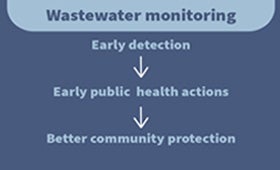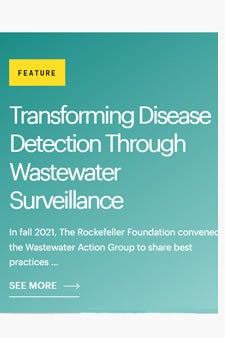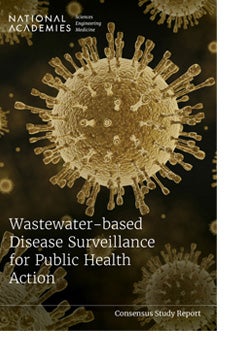National Efforts in Wastewater Epidemiology
Houston Wastewater Epidemiology team members collaborate with a wide network of partners that include scientists, public health officials and specialists to help:
- Refine wastewater sampling, testing, and sequencing protocols;
- Develop metrics and strategies that provide a full picture of infectious disease outbreaks; and
- Share best practices and scale up wastewater monitoring to detect and contain public health threats.
Collaborative efforts have included active participation in nationwide studies and reports conducted by the:
- Centers for Disease Control and Prevention (CDC)
- The National Wastewater Surveillance System (NWSS)
- Wastewater Action Group and the Rockefeller Foundation’s Pandemic Prevention Institute (PPI) and
- National Academies of Sciences, Engineering, and Medicine and the National Academies’ Committee on Community Wastewater-based Disease Surveillance.
A list of scientific manuscripts published by Houston Wastewater Epidemiology team members is at https://hou-wastewater-epi.org/science-and-innovation/manuscripts.
Reports and Briefs
The following is a list of reports and briefs co-authored by Houston Wastewater Epidemiology team members to help establish nationwide standards for wastewater-based disease surveillance.
 Increasing the Utility of Wastewater-based Disease Surveillance for Public Health Action
Increasing the Utility of Wastewater-based Disease Surveillance for Public Health Action
A Phase 2 Report by the National Academies of Sciences, Engineering, and Medicine, a study — undertaken by the Committee on Community Wastewater-Based Infectious Disease Surveillance
The Phase 2 report details the technical constraints and opportunities to improve wastewater surveillance for the prevention and control of infectious diseases in the U.S. It recommends improvements in the consistency and quality of national wastewater sampling, testing, and data analysis, and identifies research and technology development needs for a national wastewater surveillance system that can serve ongoing and changing public health needs in the United States.
 Notes from the Field: The National Wastewater Surveillance System’s Centers of Excellence Contributions to Public Health Action During the Respiratory Virus Season — Four U.S. Jurisdictions, 2022–23
Notes from the Field: The National Wastewater Surveillance System’s Centers of Excellence Contributions to Public Health Action During the Respiratory Virus Season — Four U.S. Jurisdictions, 2022–23
https://www.cdc.gov/mmwr/volumes/72/wr/mm7248a4.htm?s_cid=mm7248a4_w
Wastewater surveillance provided a valuable tool for monitoring SARS-CoV-2 circulation during the COVID-19 pandemic; surveillance has expanded from 20 to 53 jurisdictions across the United States, with increasing capacity to test for more respiratory pathogens. National Wastewater Surveillance System (NWSS) Centers of Excellence in California, Colorado, Wisconsin, and Houston used wastewater surveillance data to guide public health action in response to respiratory illnesses (COVID-19, flu, respiratory syncytial virus [RSV], and enterovirus) during the 2022-23 respiratory virus season.
Four CDC-funded NWSS Centers of Excellence were established during 2021–22. During 2022–23, wastewater sampling covered a large proportion of the sites’ populations: 94% (Houston, Texas), 67% (California), 65% (Colorado), and 50% (Wisconsin). https://www.cdc.gov/nwss/
 Transforming Disease Detection Through Wastewater Surveillance
Transforming Disease Detection Through Wastewater Surveillance
A series of reports by the Rockefeller Foundation’s Pandemic Prevention Institute, Mathematica, and the Wastewater Action Group.

Wastewater-based Disease Surveillance for Public Health Action
A consensus study report by the National Academies of Sciences, Engineering, and Medicine.
This Phase 1 report, released in early 2023, examined the usefulness of the NWSS during the COVID-19 pandemic, described the potential value of a robust national wastewater surveillance system beyond COVID-19, and provided recommendations to increase the public health impact of such a system.
